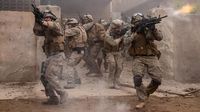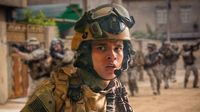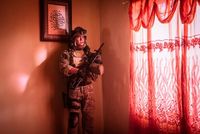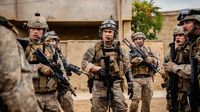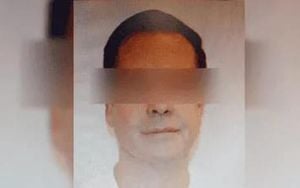In an era where war films often tread the line between glorification and reality, "Warfare" emerges as a stark, immersive portrayal of the Iraq War, specifically a 2006 mission gone awry involving a platoon of Navy SEALs. Co-directed by acclaimed filmmaker Alex Garland and former Navy SEAL Ray Mendoza, the film eschews traditional storytelling for a visceral experience that thrusts audiences into the chaos of combat.
The film opens with a nostalgic nod to youth, featuring the upbeat track "Call on Me" by Eric Prydz, as a group of young soldiers, barely out of their teens, gather in a barracks near Baghdad. This light-hearted moment quickly dissipates as the narrative shifts to the gravity of their mission. The soldiers, including Ray (played by D’Pharaoh Woon-A-Tai), Captain Erik (Will Poulter), Sam (Joseph Quinn), Jake (Charles Melton), Tommy (Kit Connor), Brian (Noah Centineo), and Lt. Macdonald (Michael Gandolfini), find themselves embroiled in a fight for survival when their surveillance mission in Ramadi encounters unexpected hostility.
"Warfare" does not follow the conventional arc of character development. Instead, it presents the SEALs as anonymous figures, representing the collective experience of soldiers rather than individual heroics. This choice is deliberate, as Garland and Mendoza aim to immerse viewers in the soldiers' world, emphasizing the intense camaraderie and the dire situation they face. The film unfolds in real-time, capturing the tension of the moment as the platoon occupies a house, inadvertently holding the family inside hostage while they prepare for an impending confrontation with insurgents.
Garland, known for films like "Ex Machina" and "Civil War," collaborates closely with Mendoza, whose firsthand experiences lend authenticity to the narrative. The screenplay, crafted from interviews with Mendoza's unit, seeks to recreate the mission as accurately as possible. "It’s an exercise in trying to recreate a real sequence of events as accurately as possible," Garland told CNN, highlighting the challenges of memory and the need for a straightforward depiction of events.
The film's structure is devoid of exposition, focusing instead on the immediacy of combat. As the situation escalates, the sound design becomes a character in itself, enveloping viewers in the cacophony of war. The immersive audio experience, crafted by Glenn Freemantle, captures everything from distant gunfire to the haunting cries of soldiers, creating a sensory overload that mirrors the chaos of battle.
While some may find the lack of backstory and character development challenging, this choice reinforces the film's commitment to realism. The soldiers' experiences are rendered without embellishment, showcasing the brutality and unpredictability of war. Mendoza's intention was to provide a corrective lens to how veterans are often portrayed in cinema, emphasizing that many filmmakers lack the lived experience of combat. "Traditionally, the people who are making movies about war haven’t experienced it," Mendoza remarked, aiming to bridge the gap between representation and reality.
In preparation for their roles, the cast underwent a rigorous three-week boot camp, learning weapons handling, tactical maneuvers, and military protocols. This training fostered a bond among the actors, as they shared the physical and emotional challenges of embodying soldiers in a high-stakes environment. "The bootcamp did two things for us," Poulter noted. "It gave us a condensed technical skill set in order to play a Navy SEAL and it also bonded us all in an amazing way."
The film's pacing reflects the reality of military life, interspersing moments of tension with periods of boredom. Quinn, who plays Sam, emphasized the significance of this contrast, stating, "There’s so much downtime, and these men have to fill that downtime. The contrast between being idle and bored, and then being in a very perilous, dangerous situation, is quite interesting." This approach challenges the typical Hollywood narrative, which often sensationalizes war, instead offering a more nuanced portrayal of the soldiers' experiences.
As the mission deteriorates, the film does not shy away from depicting the consequences of violence. The brief, intense moments of combat are juxtaposed with the emotional toll on the soldiers, exploring the shared trauma that accompanies such experiences. Mendoza described the process of reconstructing the events as an opportunity to process his own trauma, stating, "It’s a never-ending process. Just because the war is over, it doesn’t mean that it’s over for us."
The film concludes with a poignant coda, reminding viewers of the human cost of war. In a symbolic gesture of solidarity, many cast members got matching tattoos reading "call on me," a testament to the bond they formed during the production. This act reflects the film's underlying theme of brotherhood among soldiers, emphasizing that even in the face of chaos, there exists a profound connection.
Ultimately, "Warfare" is not merely a war film; it is a meditation on the nature of memory, trauma, and the shared experiences of those who serve. As Garland and Mendoza navigate the complexities of war, they challenge audiences to confront the realities faced by soldiers, stripping away the romanticism often associated with combat. The film, set to release in theaters on April 11, 2025, promises to leave a lasting impact, urging viewers to reflect on the sacrifices made by those who fight on the front lines.

